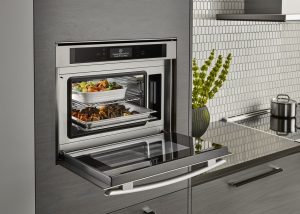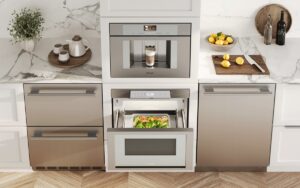All You Need to Know About Steam Ovens

Steam ovens have become a massive appliance trend over the last few years. These ovens are a great way to prepare tastier, fresher and healthier foods, but many people don’t understand how they work and how they can be of benefit. So, here we’ll explore all you need to know about steam ovens.
The Steam Oven Basics
As the name suggests, steam ovens use hot steam to cook food rather than the hot air used in conventional ovens. This introduces an entirely new level of cooking in a home kitchen and can even allow you to reheat foods more effectively than a microwave. A steam oven can be used instead of a standard convection oven or use it with your existing oven for even greater cooking power.
Most steam ovens siphon water from a small tank into a built-in boiler. The water is heated to 212ºF, and the steam is released into the oven. The super heated steam is as effective to cook food as the circulated air in a convection oven, but it is often faster. Some upscale models can be connected to a water line directly, so you don’t need to refill the tank after every use, but most models require no special hook up.
Why Install a Steam Oven?
While this may seem like hype, you can cook almost everything better in a steam oven. Steam ovens are generally thought to be healthier than a standard oven. Steam helps to lock moisture into the food being cooked or reheated, eliminating the need for additional oil or fat to keep the food moist. So, you won’t need to keep a kitchen timer handy to periodically baste your turkey to prevent it from drying out, or worry about your leftovers getting dry and inedible when you want a quick dinner.
Steam ovens can also help foods to retain natural vitamins and minerals so that you can obtain the greatest nutritional value from your meals. So, when you’ve gone to the trouble of buying healthier produce and ingredients, you can feel confident that you’ll get the best nutrients from them.
There are even some baked items that can benefit from being made in a steam oven. You can prove yeast dough in the oven and the steam during cooking can take certain breads and baked items to a whole new level.
The Potential Drawbacks
One potential downside of a steam oven is that since the water boils at 212ºF, you may struggle to cook foods that require higher cooking temperatures. Due to the temperature limit, you may prefer to combine a steam oven with a standard convection oven or choose a combo steam oven. This will allow you to cook using both convection and steam. So, you can enjoy maximum flexibility and cooking performance for any dish.
Whether you want to make your everyday foods healthier or you want to give your meals a kick, a steam oven can be a great addition to your kitchen. Whether you’re a keen home cook or you simply enjoy the convenience of reheating leftovers without them drying out and becoming unpalatable, you may wish to consider installing a steam oven in your kitchen. Steam ovens allow you to cook with minimal oil, so you can revitalize your cooking of vegetables, meat, eggs, fish, rice and leftovers.
If you are thinking about upgrading your oven and think you could benefit from a steam oven in your kitchen, you can explore the options with this online collection of steam ovens and ranges with steam function, or speak to a home appliance specialist for expert advice.
- The Ultimate Outdoor Grill Guide for 2025: Built-In vs. Freestanding
- Smart Bathroom Faucets & Fixtures in 2025: Blending Technology with Luxury Design
- Built-In Coffee Machines: Are They Worth It for Your Kitchen in 2025?
- How to Choose the Right Dishwasher for Your Home: Noise, Capacity, and Features Explained
- Top 5 Kitchen Appliance Colors and Finishes for 2025 (And How to Match Your Style)
- Why a Countertop Ice Maker is a Must-Have for Summer Kitchen Upgrades in Southern California
- How to Remove Scratches from Stainless Steel Luxury Appliances
- When Is the Best Time to Buy Appliances? Your 2025 Buying Guide
- The Ultimate Guide to Outdoor Beer Dispensers: Elevate Your Backyard Entertaining in 2025
- Choosing the Perfect Bathtub: Freestanding vs. Built-In Styles for a Luxury Bathroom






